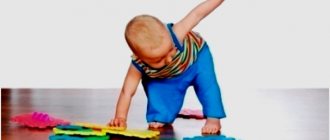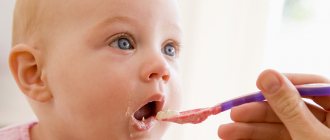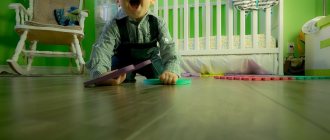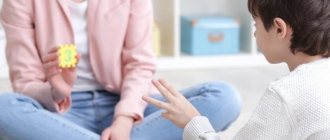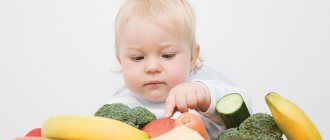The age of one year and eight months is extremely interesting in terms of the psycho-emotional development of a child.
Most often, it is at this age that children develop pronounced independence, self-awareness, and a strong sense of ownership.
Many kids begin to speak in whole sentences, some strive to help their parents in everyday activities and play with their peers.
What parameters are normal at this age, and what requires correction by a pediatrician?
Physical parameters per year and eight months
Closer to two years, children of the same age may have quite a large discrepancy in both weight and height . But still, there are certain standards that should be relied upon, and if they are strongly shifted in any direction, you should definitely consult a pediatrician.
- At 20 months, the average height of children can range from 78 to 86 cm.
- Boys' weight is considered normal between 11 and 12.5 kg, girls - between 10 and 12 kg.
- The head circumference in girls is 46.5-49 cm, in boys the normal head circumference is 48-50 cm.
- There can be either 12 or 18 teeth - all this is the age norm.
- Chest circumference for girls is 49.15 - 51.90, for boys 49.15 - 52.90 cm.
The baby’s weight gain is not so rapid; in a month it may not change at all.
Physical formation by 20 months
The main indicators of the development of a child’s body at 1 year 8 months are as follows:
- boys begin to outstrip in height, on average it is 80-85 centimeters. For girls, height varies from 78 to 83 cm.
- weight for boys is 11-12.5 kilograms, for girls - 10-12 kilograms,
- by this age there may be a different number of teeth due to individual characteristics, usually there are about 14 teeth, but in some the number can reach 17-18,
- head circumference for boys – 48-50m, for girls – 46-49cm.
By the age of 1 year 8 months, a child needs to sleep about 13 hours a day, which is quite enough for the full development of the child’s body and restoration of energy. If you have a problem putting your baby to bed during the day, passive rest will be enough: let him just lie in bed and leaf through his favorite books.
What can a baby do?
At the age of 20 months, children can differ greatly in their level of development - some babies are still very attached to their mother and are not ready for independence.
Others are able to help in the kitchen, play with peers and repeat letters after their mother.
What exactly should a baby be able to do at one year and eight months?
Try to imitate mom and dad, trying to be an adult and a useful helper. At this age, you can trust your toddler to water the flowers, sweep the floor with a broom, and carry the cups from the table to the kitchen. This is extremely useful for developing the baby’s independence.
- Be aware of yourself and your desires in a clearly expressed form - including in the form of a violent protest.
- Be able to distinguish and name colors and shapes.
- Understand where certain objects are located in the house and other familiar places, show them, and, if necessary, bring them.
- Strive to communicate with children, both younger and older.
- Run well, be able to use stairs, jump on two legs, run around obstacles, and throw a ball.
At this age, if the baby does not yet attend the nursery, it is necessary to accustom him to the first self-care skills - getting dressed, wiping his nose, washing his hands with soap, combing his hair, sitting on the potty, without waiting for an adult’s command. By the age of two, a child should be able to do all this quite well.
What children can do at 1 year and 8 months
Considering the individuality of each child, one should not focus on a specific time frame for the development of a particular skill. A child of 1 year and 8 months cannot do everything, and should not. The time will come and he will learn to speak clearly, express his thoughts and demands.
At this stage, the baby's development is as follows:
- Without the help of strangers, the baby can get the necessary object, given that he already moves quite deftly, he has developed coordination of movements, and orientation in space. At 1 year and 8 months, the baby may refuse to walk in a stroller. Instead, strive to explore all corners of the children's playground and more.
- A baby at 1 year and 8 months may show a desire to communicate with children, both peers and older ones. He is interested in communicating and playing with them.
- The development of a baby at this age is important for the speech apparatus. After all, during this period the baby should be able to speak.
Even if his vocabulary is small, and it is not always clear what the baby is saying, but a certain number of basic words should be present in it.
As a rule, during this period the baby speaks a language that he and his parents understand, but over time the speech will improve. The baby should be able to speak simple words, which include mom, dad, give, here, let's go, and others.
As speech improves, the baby may show the first attempts to compose sentences, for example, mom, give me, I’m thirsty. As a rule, closer to 2 years, the baby speaks clearly and can be understood.
At this age, many parents are concerned about the fact that their child does not speak. You shouldn’t worry about this and drag your child to doctors, because it’s normal that the baby doesn’t speak yet, maybe he has other skills that are not yet available to children his age.
- At 1 year and 8 months, children are interested in various educational games that have a positive effect on their development. At this time, they are interested in drawing, painting figures, and various creative activities, in which parents are directly involved.
- At 1 year and 8 months, the baby should distinguish objects by size, color and geometric shape. Current toys during this period are all kinds of pyramids, tablets, into which you need to insert figures according to shape, color, etc.
- A child should be able to independently occupy himself/herself for 10–20 minutes, for example, adding cubes and pyramids. Interest in watching cartoons is growing.
- The first attempts to ask to go to the potty appear. Experts consider this time to be optimal for weaning a child off diapers.
- The baby knows how to show his emotions and react to the emotions of others. He understands perfectly well when his mother is upset by his behavior, and when, on the contrary, she rejoices at his achievements. Along with emotions, character can also appear.
Parents need to fully support and encourage children at this age, whose development occurs every day. You should not compare your baby with peers who already know a lot of things.
Soon your baby will certainly master this, but for this he needs some time. All indicators for this age are average, and deviations from them do not indicate a delay in the baby’s development. If parents are confused by certain developmental deviations, they can consult a specialist.
By the age of 20 months, it is typical for a child to declare himself as an individual, defining his tastes and priorities, standing out from the general rules and framework. However, the development of a child at 1 year and 8 months has common features with the development of his peers with acceptable variations.
- Physical formation by 20 months
- What can a child of 1 year 8 months know and be able to do?
- Nutrition and hygiene
- Learning by playing
Features of child development at 1 year and 8 months
Features of the psycho-emotional sphere
At the age of 20 months, the child develops a strong sense of self.
The baby develops “stubbornness”; he can vigorously defend his interests, push other children, preventing them from encroaching on his property - toys and books.
Many adults attribute this behavior to poor upbringing, but this is an age-related feature that is extremely difficult to combat.
Important! Under no circumstances should you physically punish a child at this age. This will not only have no effect, but can also deeply wound the psyche. Neuroses that arise at such a young age will be very difficult to treat.
If your baby is naughty, rule out the possibility that he is hungry or tired. Children closer to two years old may forget about physical needs, getting carried away by play, and become capricious without realizing the reason.
Speech abilities
Speech development after a child reaches the age of one and a half years moves to a new level. A child of one year and eight months is already able to recognize direct connections between objects and the words that denote them. The baby replenishes both his passive and active vocabulary every day.
Important! At 20 months, children should be able to pronounce simple words - “mama”, “give”, “moo-moo”.
Many children at this age are already actively chatting, and their speech can be quite complex. The more books they read to a child, the more they talk to him, the richer his vocabulary will be. At 20 months, a child can have either 15 words or more than a hundred words in his vocabulary.
If the baby does not speak yet, you should not panic, but communicate with him more, and more often allow him to play with older children.
If the child still does not speak at the age of 2-2.5 years, then it is worth consulting with a speech therapist.
Intellectual level
By this age, almost every child already understands for sure: he and his mother are two separate people, with their own characters, their own desires. And he wants to prove his own importance. This is expressed not only by stubbornness or whims. At this age, children show a willingness to help their mother in all her household chores. Often such assistance results in a threefold increase in time costs. But if you start to suppress such attempts of a child, he will very quickly stop imposing “his services” and not only will not acquire the necessary skills, but will also feel unnecessary. And this inevitably leads to new behavior problems. Therefore, mothers will need all their strength, patience, and wisdom.
What else is noticeable about the development of children of this age?
- They already know how to accurately express desires, even demand, actively resist if they are forced to do something by force, saying a firm “no!”
- They distinguish all the primary colors, and often their shades, and know the basic geometric shapes (triangle, circle, square).
- They know where this or that object is (even if it is not visible), they can find it and bring it upon request.
- They begin to take an active interest in their peers and make attempts to play together.
Now is the time to accustom your baby to the proper use of household items (no brushing with a toothbrush, no need to put the potty on his head, a curtain is not a napkin, gloves are not socks, etc.).
Diet
By the age of two, the baby should be able to independently eat liquid dishes - soups and cereals - with a spoon, and be able to hook a piece of meat or vegetables with a fork.
If a child does not know how to do this, it is necessary to give him more practice, change the consistency of dishes, encourage him with words, and do not rush to feed him.
In order for a baby to grow and develop normally, his diet must contain almost the same foods as an adult - meat and dairy products, vegetables, fish, herbs, and a lot of seasonal fruits.
At the age of 20 months, your baby can be pampered with any berries - the main thing is to introduce them into the diet gradually , monitoring the condition.
Sample menu
It is worth feeding a child at this age 4 times a day, and breakfast should make up at least 20 percent of the daily diet, lunch - about 40, dinner - 30, and 10 percent of a light afternoon snack.
For breakfast, you can prepare any milk porridge with the addition of a piece of butter, an omelet from one egg with low-fat cheese and vegetables, a piece of bread with butter, cheese or boiled chicken breast.
For lunch - soup based on vegetable or chicken broth. Children at this age happily eat chicken soup with noodles, vegetable cabbage soup, and soup with meatballs. Borscht and cabbage soup can be seasoned with low-fat sour cream.
For main course and dinner - stewed or baked vegetables, chicken breast or veal cutlet, fish cutlet, meatballs with vegetables and gravy.
For an afternoon snack - any fermented milk product - fermented baked milk, snowball, yogurt with a bun or your favorite cookies.
Between meals, you can offer your baby fruits - chopped apples or pears, seasonal fruits - melon, cherries, watermelon, berries - raspberries, currants, gooseberries, strawberries only from your own garden or from a trusted farmer.
Dish recipes
“Hedgehogs” with rice and vegetables
- 200 gr. minced chicken;
- 0.5 cups washed rice;
- two - three cauliflower inflorescences;
- small carrots.
Boil carrots and broccoli, grate. Add the vegetable mixture to the rice and minced meat. Form small balls.
Place the “Hedgehogs” loosely in a saucepan, add cold water just above the balls, bring to a boil, reduce heat to low, and add a little salt.
Cook for about 40 minutes, serve with sour cream.
Process nuances
Each type of activity (games, food, walks, learning) must be carried out in compliance with certain nuances. With their help, you can make your child more energetic and cheerful.
Nutrition rules
In order for a child to grow up healthy and receive all the necessary vitamins, he needs to be provided with proper and balanced nutrition. The best option would be to distribute food evenly throughout the entire waking period. Doctors recommend following the following frequency:
- Children under 3 years old. At this age, it is enough to provide four meals a day (breakfast, lunch, afternoon snack, dinner).
- From 3 to 5 years. Babies belonging to this age category are also recommended to eat 4 times a day. At the same time, light snacks (fruit, ice cream, sweets, desserts) are allowed between meals.
- From 5 years to school entry. Children at this age should be provided with five meals a day as they need more energy to learn and prepare for school.
It is equally important to choose the right products for your daily diet. All harmful ingredients that can negatively affect the functioning of the digestive system should be excluded from the general list.
Key points to consider when choosing products:
The daily diet must include the following ingredients: butter, milk, stewed or steamed meat, porridge (rice, buckwheat, oatmeal), potatoes, bread, as well as fresh vegetables and fruits. About 2 or 3 times a week you need to pamper your child with fish stews, cottage cheese, hard cheese and eggs. The preschooler's menu should constantly change
It is important that the products consumed are repeated as rarely as possible. Meat must be combined with cereals or vegetables. It is recommended to give your child a small portion of salad before meals. With the help of this dish, the secretion of gastric juice will be stimulated, which will have a positive effect on appetite. Sweet and juicy fruits are best eaten in the evening.
Sleep organization
In order for the baby to fully rest, it is necessary to provide him with appropriate conditions. The optimal duration of sleep depends on age and individual characteristics of the body. Children under 5 years old are recommended to rest at least 12 hours a day (9 hours at night and 3 during the day). Older boys and girls should sleep 1 hour less.
In order for the child to fall asleep quickly, it is recommended to avoid activities that excite the nervous system 1-2 hours before rest. These include:
- noisy games;
- sitting at a computer;
- watching TV.
Very often, preschoolers refuse to nap during the day. You can replace it with some low-active activities (reading, passive games, lying on the bed). Lack of sleep leads to poor mood, health, and learning ability.
Walking and physical activity
To improve health, it is necessary to include regular walks in the fresh air and outdoor games in a preschooler’s daily routine. Doctors recommend walking regularly, except on rainy and very cold days. Daily walks will help improve:
- metabolic rate;
- functioning of the cardiovascular system;
- resistance to various diseases;
- state of the respiratory system.
A combination of fresh air and physical activity will be beneficial for your baby. It is allowed to perform any actions that will help strengthen health and immunity. It's best to do:
- running warm-up;
- sports games (football, basketball, badminton);
- exercises aimed at strengthening the muscular system (pull-ups on the horizontal bar, push-ups);
- entertaining games.
Features of hygiene and care
At the age of 1 year and 8 months, the child can be bathed both daily and every other day.
It is important at this age to teach your child to use the potty independently.
You should gradually give up diapers, wearing them only for walks.
It is necessary to teach your child to wash his hands with soap before eating, after walking and playing with pets - by the age of three, this habit should become natural.
At 20 months, a child is not able to brush his teeth well on his own - you need to help him, but definitely show him how to do it correctly.
Note! The baby should have his own children's toothbrush and toothpaste, appropriate for his age, without fluoride and chemical flavors.
What to do to ensure that your child develops correctly
Here's how you can support your baby's development at 14 months:
- Involve your child in household chores.
Children at this age love to repeat after their elders and participate in everything that family members do. Invite your child to help you with simple household chores. For example, turn on music and collect toys together in a basket. Let it be a fun and enjoyable activity, don’t rush your baby, help him and praise him for helping you put things in order. You can also ask your baby to help you put the milk on the bottom shelf of the refrigerator or “sweep” the floor. He will be pleased that he is entrusted with matters as a “big man.” Helping is also an important social skill that a child must gradually master.
- Let your child spend time with other children.
You may notice that your baby becomes interested in the company of other children, especially when they are older. While he will play alone, even surrounded by other children, this is called parallel play. Later he will learn to play with the children. At this age, the child is still focused on himself, in his perception he is at the center of events, so he cannot show empathy and look at the situation from someone else’s point of view. At 14 months, a child does not yet know how to share and may become upset if another child takes a toy from him, even if he offered it to the other child himself.
- Use ordinary words.
Your child understands speech better now, so try to name objects as they are actually called. For example, if there is a picture of a car in a picture in a book, when pointing at it, say “car” instead of “beep”. It will be easier for the child if one name is associated with one object.
- Practice discipline.
By discipline we mean teaching and support, not punishment for something the child has done wrong. Now and in the years to come, your child will test boundaries and discover their own capabilities. For example, he may scream when you take something away from him, or throw food on the floor even after you ask him not to. Over the coming years, you will consistently set these boundaries for your child (this is what we call discipline), and the child will respond by learning to behave as you expect and developing the necessary self-discipline. For successful parenting, parents must have solidarity in understanding boundaries, that is, what is allowed and not allowed, so discuss the chosen tactics together. Consistency of the rules will help the child learn them and save him from situations in the future when the child says: “But dad / mom allows me...”
Day and sleep routine
At 20 months, a child should sleep at least 13 hours a day - 10-11 hours at night and at least 1 hour during the day.
Daytime naps are extremely beneficial for children of this age. If the baby does not want to sleep during the day, it is necessary to consult with a pediatrician and also adjust the regime - perhaps the child does not fall asleep well immediately after a walk or after a hearty lunch.
You need to walk at least twice a day - in the morning after breakfast and in the afternoon, after sleep or before it. If possible, it is advisable to take your baby for a walk in the evening, shortly before bedtime.
Dr. Komarovsky believes that for children under the age of two years, the daily routine is no less important than for infants. Try to put your baby to bed at the same time, and feed him, even if not by the clock, but at approximately equal intervals.
Activities with your baby
Games
With a baby at 20 months, it is necessary to play outdoor games - this promotes the development of the vestibular apparatus and strengthens the muscles of the body. Football on the grass, throwing the ball to each other, trying to throw a ring on a stick are very useful at this age.
To develop social skills, you can play role-playing games with your child - daughters and mothers, in the profession of a doctor, fireman, veterinarian). Kids are happy to get involved in such games; after a while, children the same age will be able to play them on their own.
Toys
For role-playing games, children will happily use ready-made sets - for example, a doctor or a hairdresser.
As children approach two years of age, they begin to become interested in puppets, including glove puppets, with which they can stage small scenes from their favorite fairy tales. Children happily assemble construction sets, small, four to eight-piece puzzles.
Our website also contains materials about the following periods of babies’ lives: one year and 9 months, one year and 10 months, one year and 11 months.
Our lesson plan for ages 1.8 - 2 years
Throughout the week I ticked off the things we did. I didn't have a goal to do everything. But I tried to do at least one thing from each point every day and not repeat activities day after day. On Sunday morning I washed everything and started again on Monday. Usually we were 80 percent done.
In principle, this plan is clear, but what I emphasized. Until two years of age, the main thing is the development of speech, familiarity with the world around us through experience, and aesthetic development.
Finger gymnastics, logorhythmics, and pure phrasing are present with us every day. Of the manuals, my favorite was the Speech Development Album for Kids. We also did the exercises proposed in it while playing with cards and toys. I showed my husband something and asked him to do the same in German.
In the fine motor skills unit, games with water and stickers were and remain the most favorite. I always involve Nastya in participating in household chores, especially in cooking. Nastya doesn’t like finger steps (I still sometimes suggest them), but she likes the trailing steps, and now it’s starting to work out well. Until the age of two, there were, of course, mostly kalyaks.
Nastya’s sensory boxes have not become a hit; I don’t even make them every week, but only when the weather is good and we are playing in the country.
Creativity is my daughter’s favorite thing. She likes and liked everything. I’ve been cutting with her for a long time now, and I give her safe scissors even without supervision. So we've always had a lot of boxes ticked here.
The point on developing the right hemisphere, apparently, reflects Shichida’s technique. It is not very close to me, especially in terms of developing intuition and the need to form photographic memory. But, of course, the advantages of memory development are obvious to me. And the so-called development of imagination, even if it does not work in the Shichidian sense, is very useful for the development of speech.
Intellectually, I did not have a goal to actively develop logic at such an early age, since I believe in the theory of sensitive periods. And Nastya herself, until she was two years old, had no particular interest in either puzzles or sequences. Therefore, the main thing in terms of intellectual development for us was familiarity with the world around us and its properties. Now I’m drawing up a new plan for us and I want to describe this point in more detail.
We were doing very well in color recognition games, more or less lotto and systematization. I offered the remaining points little by little.
Musical development. Since Nastya was 6 months old, I have been playing music in the background every day. Previously, Nastya didn’t care what she was playing, now she asks for something specific. And more and more often these are not classics, but songs from cartoons (we almost never watch cartoons themselves, we only listen to songs). We get musical instruments about once a week, sometimes Nastya herself asks for them, then we arrange joint “concerts”.
I made a separate point about role-playing games. Until the age of two, most children do not yet know how to play them, but they can be taught and interested. In the new plan, I will not have such an item, since Nastya now plays role-playing games herself, my initiative is not needed for this.
I included the last point simply as a reminder to myself that there is no need to constantly rush to help Nastya with everything, to perform everyday tasks for her. It turned out to be very useful, otherwise I kept trying to dress, undress, and feed her myself.


